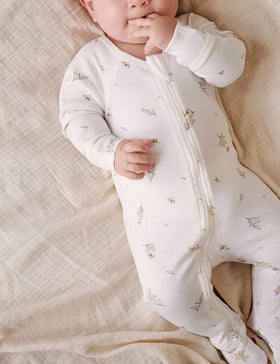
Guide to Safe Baby Toys for Newborns
As parents, one of our top priorities is to provide our children with quality, healthy, and safe environments to grow and thrive. Part of that commitment includes selecting the best natural baby products for our little ones. In recent years, there has been a surge in the popularity of organic and eco-friendly baby products. When it comes to toys, it's crucial to choose items that are safe, non-toxic, and free from harmful materials such as plastics.
We will explore tips for parents seeking high-quality, natural, organic baby toys. From sustainable rattles and teethers to eco-friendly developmental toys and comforting stuffed animals, let's dive into what makes a safe and nurturing plaything for your newborn.
Why Choose Natural and Organic Baby Toys?
Regarding baby toys, choosing natural and organic options made from eco-friendly and non-toxic materials is more than just a trendy choice. It's a way to create a healthier and safer environment for your precious newborn while supporting sustainable practices for our planet. Here are some key reasons why opting for natural, organic, and sustainable baby products is essential:
-
Safety: Natural and organic toys are free from harmful chemicals, such as phthalates, lead, and PVC, that can be found in conventional plastic toys. These non-toxic materials significantly reduce your baby's risk of health issues and allergies.
-
Durability: High-quality, natural baby products are typically more durable and long-lasting when compared to cheaper alternatives. As a result, they provide extended playtime and can be passed down to future siblings or even generations.
-
Sustainability: By choosing toys made from renewable, responsibly sourced materials, you're supporting eco-conscious brands and helping reduce our overall environmental impact.
Types of Natural and Organic Baby Toys
Various types of natural and organic baby toys are available on the market. Let's take a closer look at some popular categories and their benefits:
Rattles and Teethers
-
Made from natural wood or food-grade silicone, these toys provide sensory stimulation and relief for teething babies.
-
Look for options that are free from toxic paints and finishes.
Developmental Toys
-
Engage your baby's cognitive, motor, and sensory skills.
-
Opt for toys made from sustainable materials such as wood, bamboo, or organic cotton.
Stuffed Toys
-
Made from organic cotton or other natural fibres, they provide comfort and companionship to your baby.
-
Ensure that the filling is made from hypoallergenic, eco-friendly materials.
Choosing the Right Brands
Not all baby toy brands are created equal; therefore, it is essential to be selective when choosing products for your newborn. Look for companies that prioritize safety, use only non-toxic materials, and adhere to strict quality standards. Additionally, consider the manufacturing process and whether the company is transparent about its sustainability practices and materials sourcing. By supporting such brands, you're making a responsible choice for your baby and the environment.
The Bottom Line: Quality Matters
When it comes to our children's well-being, quality should always be at the forefront of our decision-making process. Choosing non-toxic and eco-friendly toys is vital in ensuring your newborn's safety and overall health. Steer clear of plastics and be cautious about the brands you purchase products from, as not all companies prioritize the same values. By making thoughtful and informed choices, you can provide your baby with high-quality, natural baby products that will nurture their growth and development safely and sustainably. So make the switch today and support the movement towards a greener, more responsible future for our little ones.


